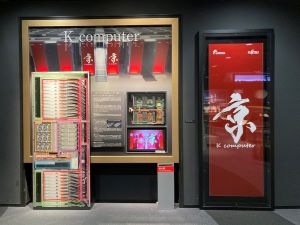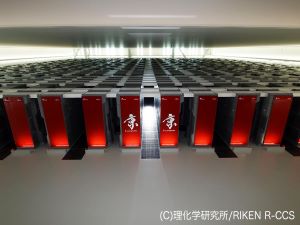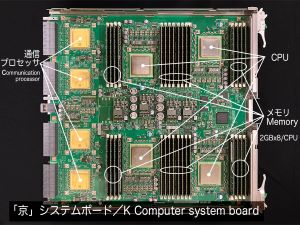Nagoya City Science Museum
TOP > Exhibition Guide > Keyword Search > Starting with "S" > Supercomputer > K computer
K computer



Purpose of Exhibition
Supercomputers, so-called “SUPA-KON” in Japanese language, play an active role in the world of simulation which includes weather forecasting, earthquake/tsunami forecasting, drug development and so on.
In this exhibition, one of the actual racks of RIKEN’s Supercomputer “K” that had been in operation until August 2019 is displayed, and the K computer’s functions are shown.
Additional Knowledge
□ What is the K computer?
The K computer is a supercomputer that was used for about 7 years from September 2012 to August 2019 at the RIKEN Center for Computational Science (R-CCS) in Kobe City, Hyogo Prefecture. It is capable of performing ten quadrillion (1016=10,000,000,000,000,000) calculations per second. To perform the same number of calculations, it would need 17 days even if all 7 billion human beings on the earth calculated once per second.
□ The size of the K computer
The K computer comprises 864 computer racks, each of which is approximately 1 m long, 1 m wide, and 2 m high and connected to each other. Each rack
weighs 1 ton and contains 24 system boards, communication/storage devices, cooling devices, and power supplies. In total, the computer uses more than 200,000 electric wires, whose total length amounts to more than 1,000 km! The room that once housed the 864 racks has a floor space of 50 x 60 m without any pillars. Since a huge amount of heat is generated during the operation of the K computer, a dedicated building is required for air conditioning equipment to cool the room.
□ Why is it exhibited at this museum?
The 864 racks are not designed to be operated individually. To reuse the K computer as a supercomputer, whose use has once ended, it is necessary to receive all 864 racks, preparing a dedicated room (and a building) to store them and relevant equipment. Unfortunately, there was no institution willing to do that.
Therefore, RIKEN decided to transfer the actual components of the K computer to science museums and other facilities for exhibition to disseminate information relating to its capabilities and the uses of supercomputers. As a result, its components have been transferred to and are now exhibited at 10 science museums in Japan, including us.
□ K computer’s amazing ability
While a so-called typical personal computer has only one CPU, one rack of the K computer contains nearly 100 CPUs. That already indicates that the K computer has a great calculation capability. However, its biggest advantage is not the speed of each CPUs but rather its capability to allow the CPUs to communicate with each other and perform a huge number of calculations simultaneously. In total, the K computer, which comprises 864 racks, has 80,000 CPUs. In order to enable such a large number of CPUs to efficiently perform calculations, epoch-making technologies have been incorporated into it, relating to the communication method between CPUs, and the calculation software. This is truly one of the strongest points of the K computer.
□ Award history
There are several awards that recognize the performance of supercomputers around the world. The K computer has received the following awards.
Supercomputer TOP 500
First place: June/November 2011
Second place: June 2012
Third place: November 2012
HPC Challenge Award (Class 1)
2011, 2012, 2013, and 2014
HPC Challenge Award (Class 2)
2013
Gordon Bell Award
2011 and 2012
Graph 500
First place: 2014, and for nine consecutive terms from July 2015 to June 2019
□ Post-K computer
Fugaku is the successor to the K computer. Aiming to achieve 100 times the performance of the K computer, a trial operation of Fugaku started in April 2020, and full-scale operation is scheduled to start in 2021. In June 2020, it ranked first in the TOP 500 and also in the HPCG, HPL-AI, and Graph 500 rankings.
■ References
RIKEN K computer website https://www.r-ccs.riken.jp/en/k-computer/
Fujitsu K computer website https://www.fujitsu.com/jp/about/businesspolicy/tech/k/
RIKEN Fugaku website https://www.r-ccs.riken.jp/en/fugaku/
□ Article by Tetsuro Ojio, curator
